The Back Four: 2025 USL attendance, prediction revisits, and more
Featuring attendance data, egg on my face, and more USL miscellany
Welcome in to The Back Four! It’s a slightly truncated version this week for two reasons: I’ve got a big League One playoff preview coming, two Championship pieces are en route, and the Super League had an inexplicable bye week.
In the meantime, visit Backheeled for more USL content like my final Championship power rankings. Also, check out This League! for an audiovisual dive into the week that was.
Without further ado, let’s get to it.
Attendance Data!
We’ve hit the end of the 2025 regular season, so it’s time to recap the year in attendance trends. Let’s start with the USL Championship:
At a headline level, the Championship’s attendance is up to 5,500 per match across Jagermeister Cup and regular season games, amounting to a 5% increase year-over-year. On a team-for-team basis (i.e., excluding Lexington in 2025 and Memphis in 2024) that same growth rate holds.
Improvement was carried by clubs at new venues. Rhode Island FC led the way at Centreville Bank Stadium in Pawtucket, vaulting into the top five of the attendance standings. The Oakland Roots’ relocation to the Coliseum more than doubled their average, while Lexington SC’s first full season at their own soccer-specific facility yielded the biggest multiplier in the Championship. However, the median growth rate came in at -2% as a number traditional markets saw small-but-significant drops.
Similar trends defined the slate in League One:
Again, the headline numbers were strong in the third tier. League One’s average match attendance leapt to 2,797 this season – an 11% climb. However, year-over-year attendance for the division’s nine returning clubs actually decreased by 4%, with a median growth rate of -6.5%.
For my money, the success of League One’s expansion class is the biggest story across the USL pyramid. Portland Hearts of Pine smashed the league attendance record; AV Alta and FC Naples both slotted into the top five of the attendance table. On the stadium front, Knoxville’s relocation to Covenant Health Park helped them to the biggest improvement (82%) in League One; Players’ Shield form didn’t hurt either.
The elephant in the room across the USL is the drop in attendance among legacy clubs. Some of that issue owes to changes in ticket-counting or stingier giveaways; when I checked in at midseason, for instance, I was told that Louisville City had significantly cut down on freebies. That’s the challenge of attendance tracking: what looks like an on-paper decline can actually be an *increase* in paid ticket-holders, but it’s nigh impossible to separate those cases from legitimate drops.
No matter what, all eyes are on 2026 as a make-or-break moment. The men’s leagues are adding half-a-dozen new teams, and you can’t talk to a USL executive without hearing about the World Cup bump to come. The onus is on clubs to meet the moment; even if interest in soccer explodes, USL organizations need to actually capture those new fans.
How the West was won (and lost)
In terms of their style of play, FC Tulsa and Lexington SC couldn’t be more different. We think about Tulsa as one of the USL’s most aggressive, vertical teams. Lexington, by contrast, is stereotyped as a side that patiently builds out of the back before nesting in the final third. That’s probably over-simple; Tulsa has become more possessive since adopting a 4-2-3-1, and many of Lexington’s best spells have centered on their counterattacking speed.
No matter where the systems land, one thing became clear in Week 34: Luke Spencer made the right calls to stabilize his midfield down the stretch of the 2025 regular season, while Terry Boss couldn’t find a similar answer at the heart of his lineup.
Tulsa certainly hadn’t been bad in recent weeks – they’d only lost once since the start of September entering Saturday’s match against Colorado Springs. Nonetheless, injuries to AB Cissoko and Boubacar Diallo had thrown a wrench in Spencer’s plans. Cissoko played nearly 2,000 league minutes and won 138 duels before going down, while Diallo was my midseason Defender of the Year pick because of his unbelievable coverage out of the No. 6 spot.
With Cissoko joining fellow center back Arthur Rogers on the long-term injured list, a move into a back four was logical. Of course, that change didn’t solve a Diallo-sized problem in the pivot. Enter Delentz Pierre, a career defender that stepped into the midfield with aplomb over the weekend.
Consider the situation here…
…where Pierre is essentially operating like a single pivot at the far right of the game as his midfield peers recover into shape. The ostensible attacking mids in the 4-2-3-1 are denoted in black, whilst the pivot is in a tan-gold hue.
If you’re going to catch Tulsa out, the best way to do it is by leveraging moments of chaos. Pick up possession in a second-ball situation off a goal kick? You might have room to break. Colorado Springs has done so here, finding space between the lines of what’s effectively a wide-spaced 4-1-4-1 on the other side.
I’m not saying it’s a great position to be in, but Pierre instantly puts himself in a spot to make a difference and stop the potential bleeding. No matter which of their attacking mids the Switchbacks try and hit, Pierre stands ready to close them down in an instant. The only legit choice is to try and play over Pierre’s head – a low-percentage option if there ever was one.
Here, Tulsa’s restarting long once more, and they’ll end up with the knockdown in this case. You see Pierre highlighted, and the ball will end up at his feet after a ping-ponging sequence.
When you’ve got a center back moonlighting as a midfielder, there’s no expectation of progressive brilliance. That held true for Pierre, who only attempted 12 passes in his 67 minutes. At the same time, 33% of those attempts pushed Tulsa into the final third. That’s the case in the clip: Pierre drives a pass into Taylor Calheira, setting up a lay-off that’ll yield a dangerous free kick.
In Pierre and Giordano Colli, Tulsa assembled a pivot that could defend as a low twosome but rely on a one-man anchor in transitional or all-out-attacking moments. For Lexington last weekend in Oakland, that balance never arrived between Nick Firmino (subbed off at halftime) and Blaine Ferri.
Again, I know the systems are different, but let’s compare the numbers between Pierre and the Lexington defensive mids:
Firmino and Ferri contested 12 total duels; Pierre did that by himself.
Firmino and Ferri attempted one tackle and made one interception; Pierre picked up two interceptions on his own.
Firmino and Ferri attempted 72 passes, 23 of which were aimed forward by my back-of-the-napkin count. We know how Pierre’s passing math-ed out in terms of 33% final-third entrance.
Am I being intellectually dishonest? Yeah! Lexington’s midfielders are wall-passing tempo-setters. That’s their job! The numbers will innately look better for a player like Pierre in a system that lets him off the leash.
My argument is that LSC needed similar freedom through the middle. Firmino had limited license to turn upfield on the ball and advance, Giordano Colli-style. Ferri did well as a recycler, but he struggled to balance line-breaking needs with defensive contributions. At no point did Lexington have a semblance of a No. 6’s presence – notable as reigning champion Speedy Williams languished on the bench.
Would Williams have stopped a chance like this, with the midfield entirely played past and the Roots’ rival strikers bearing down in a two-on-two? Maybe, maybe not, but Lexington played such an outwardly offense-first lineup that they never had the chance to find out.
The best soccer teams, with rare exception, are defined by a sense of balance. Tulsa used Week 34 to restore their balance by reinventing Delentz Pierre. Lexington’s season is over because they never found a similar answer in 2025.
League One potpourri
As mentioned, I’ve got a playoff deep-dive coming soon. In the meantime, here are some quick thoughts from Week 34.
Naples’ resurgent offense
After six scoreless matches, Karsen Henderlong finished the regular season in style for FC Naples, nabbing a brace in a resounding 2-0 victory against Charlotte on Saturday. Naples put up 1.73 xG in the process (their highest return in about a month) and did so without straining their system or taking major tactical swings. Above all else, Matt Poland’s side looked like a high-chemistry attacking unit.
Against an Independence team that adopted more of a 4-4-2 defensive look, Naples tended to build in a 2-4-3-1 shape that could combine to create overloads against the opposing pivot. Charlotte didn’t press with all that much aggression, so Naples could take their time in picking out patterns up the middle. While the guests ended up with 55% of the ball and a near two-thirds field tilt, they lacked the clarity that Poland’s side brought in attack.
Here, Jake Dengler carries the ball from the right-sided center back spot, facing a half-hearted close from Charlotte striker Christian Chaney. Because Naples keeps their double pivot in front of the Independence’s midfield line, there’s a gravitational effect that opens space between the lines. Thus, Dengler can hit Henderlong at his feet and set up a three-man combination through the right channel.
While the striker’s pass into an overlapping Max Glasser isn’t smooth, it still sets Naples up with a localized three-on-two. The hosts keep pushing into winger Ian Cerro, who nearly finds a crashing Kevin O’Connor at the far post.
Naples’ best moments originated from similar positions, where the base of Dengler and Brecc Evans paired with the pivot of Marc Torrellas and Chris Heckenberg to challenge Charlotte’s vertical compactness. O’Connor was especially clever about leveraging that phenomenon as a second-wave runner, dropping low from the No. 10 spot to pick up touches before turning and hitting passes over the top to the wingers. Outlet passes to the fullbacks were equally effective; Julian Cisneros got a breakaway key pass in the 52nd minute through that pattern, and a leak-out by Glasser in the 64th minute gave Naples their winner.
There’s no guarantee that Naples will look as efficient next weekend against Omaha, but the basic tenets should apply against Los Búhos’ squint-and-it’s-similar 4-4-2 press. If Henderlong stays hot as a premier finisher and between-the-lines creator, anything can happen.
Continued shape change in Chattanooga
I’m generally dubious of average position charts. They tend to be overly simple, and they can mislead if a player changes positions halfway through a match. That disclaimer out of the way, Chattanooga’s player map from their season-finale win against Westchester is worth a look:
As I logged last week, the Red Wolves have suddenly become a 4-4-2 team at the very last minute. A few things to note, combining the position chart and the eye test:
Ualefi, #8, went 29 for 35 as a passer (including eight long completions) and continued to drop in like the right-sided center back in a possessive back three. That tendency paid dividends against Westchester’s front-two press, and it’ll be similarly effective against Portland’s out-of-possession 4-4-2 press in the playoffs should Scott Mackenzie stick to the shape.
Omar Hernandez (#17 above) tended to drop in like a No. 8 to fill for Ualefi, and that had advantageous knock-on effects. On Hernandez’s side, Yanis Lelin had ample room from which to overlap from the right back spot. As Chattanooga titled right, left winger Aaron Lombardi took advantage with a number of clever vertical runs into the final third, hence why he ended up with five box touches.
In block, the defensive 4-4-2 was implacable. Chattanooga conceded only seven shots and 10 box touches even as Westchester held a 56% field tilt.
None of that will be news if you read last week’s column, but it’s still a fascinating chain of events given what we saw from this club for most of 2025.
Richmond?!
If the Kickers played with as much verve and freedom as they did on Saturday night in a season-ending Henny Derby, we’d probably be talking about a playoff game at City Stadium. That obviously isn’t the case, but Richmond was flying in Week 34.
Darren Sawatzky didn’t abandon his principles in the process. Richmond rolled out a familiar 4-1-4-1 with Dakota Barnathan as a single pivot, and the goalkeeping platoon looked to tilt the pitch with direct distribution from the back. The execution, however, was exceptional. The Kickers tended to press by having their wingers (Darwin Espinal and Adrian Billhardt) take rounded closing angles against the Madison back three. Meanwhile, tight marking from Nils Seufert and Chandler O’Dwyer denied the Madison pivot.
You get the picture: Madison’s only choice was to play into a trap or hoof it long. Their 3-2-4-1 attacking shape was highly vulnerable when the Sawatzky system went to plan.
That’s what’s happening here. Spirited movement across the front line lets Seufert intercept, and then it’s off the races. The end result is a sweet goal for Emiliano Terzaghi up top.
The press’ disruptive success set the tone, but Simon Fitch also played a stellar match at right back. His timing in transitional moments was sublime, regularly catching Damia Viader sleeping on the other side. Again and again, Richmond’s front three led transition opportunities that occupied the opposing three center backs, at which point Fitch arrived to break the defense’s back. He ended up with two assists.
Richmond’s got plenty of questions to answer this winter, but you couldn’t have dreamt up a sweeter finish to 2025.
Post-mortem takeaways, Week 3
As we get to the end of the season, I want to highlight something that stands out for each of our eliminated clubs. Without further ado, let’s finish the eulogies.
AV Alta: Forging a brand
On the field, Brian Kleiban immediately made Antelope Valley into League One’s most dominant passing team. At best, Kleiban’s 4-2-3-1ish structure allowed for a quick tempo and a hyper-fluid ability to reach the final third. 60% average possession for an expansion team is crazy! In conversations I’ve had with coaches around the league, there’s a real sense of admiration for Kleiban’s style – even if it fell off a cliff late in the year.
Meanwhile, Alta did a terrific job of making their presence known at Lancaster Municipal Stadium. This team packed in more than 4,000 fans almost every single time out, easily ranking in League One’s top three for attendance. In other words, they’ve got major building blocks on and off the field.
Forward Madison: The late revival – and what it means for the offseason
Madison entered Week 33 having won four matches out of five, a run of form that largely coincided with the return of Derek Gebhard and Devin Boyce to the lineup alongside one another. Gebhard, who turned 30 this month, led Madison with 11 goals and was the team’s only double-digit scorer. Boyce, meanwhile, created 18 chances (fourth on the team) despite missing a number of matches and playing just 1,200 minutes.
If anything, Madison’s shortcoming was an over-reliance on their old favorites. Without Gebhard and Boyce – both of whom will be on the wrong side of 30 at the end of 2026 – the press never coalesced and the attack regularly wavered. The same concept applies to this club’s back three, frankly. Timmy Mehl, Jake Crull, and Mitch Osmond are Forward Madison, but at what point is change needed?
The key this winter? Mix in new blood. At full health, the old core can still do a job, but League One ain’t getting any easier. Continued opportunities faces (Dean Boltz! A return for Lucca Dourado! Insert defender here!) would go a long, long way in bringing Madison back to the postseason.
Tampa Bay Rowdies: Clear offseason targets
Not to bring up a sore subject, but Tampa Bay‘s recent 5-0 loss against Rhode Island basically underlined everything that needs to change heading into next season. For my money, it all starts with the back line. The Rowdies have relied on a core of familiar pieces for the better part of a half-decade, but they need center backs that can (1) break lines under pressure and (2) look moderately competent against the counter.
If Tampa Bay ran back everything else and improved their defense – something that’ll be necessary given Forrest Lasso’s retirement – I’d bet the farm on a playoff appearance in Dom Casciato’s first full season. Of course, running it back isn’t guaranteed. The Rowdies’ best scorer (Woobens Pacius) and creator (Paul Marie) were both on loan in 2025, and it’s unlikely to get both players back.
It’s easier to find attacking talent than to build a high-chemistry defense from scratch, but that only underlines the scope of the job ahead for Casciato. The task might be clear, but that doesn’t make it any easier.
Indy Eleven: Aging like fine wine?
33-year-old Aodhan Quinn and 31-year-old Jack Blake defied the gravity of the aging curve this year, and they might be the core of Indy Eleven’s necessary offseason retool. Quinn ended up leading the USL in assists, splitting the atom between the left wingback spot and a conventional No. 8’s role. Blake typically occupied the left halfspace but ran the positional gamut from second striker to the depths of the midfield – all while picking up 10 non-penalty goal contributions.
If that sounds like a lot of positions…well, yes! Indy often lacked offensive flow, and an inability to nail down a specific framework often cost them. Sean McAuley’s Eleven always valued verticality and back-end aggression, but the shape, focal players, and pressing philosophy seemed to change every week. Bring Quinn and Blake back, spotlight them in a consistent system, and you might just get Indy back to the playoffs.
Lexington SC: The young core
It’s deeply disappointing for Lexington to miss the playoffs yet again, underperforming lofty preseason expectations for a second consecutive year. We’ve seen it in League One, and now we’ve seen it in the Championship. Ultimately, though, my money is on Lexington taking a major step up in 2026 thanks to the groundwork laid this year.
On pure talent, Michael Adedokun is one of the best young players in the league, and he’ll be this club’s linchpin at age 24. Kendall Burks (26) and Joe Hafferty (27) can anchor an elite defense for my money. Even Latif Blessing will enter next season as a mere 29-year-old despite having spent a lifetime in MLS already. Few clubs can compete with such a core four. There’s plenty of work to do around them – see my section above! – but an elite spine is in place.
Quick Hits
In other news this week…
It’s my favorite time of the year, where I get to embarrass myself by looking back at preseason predictions. Without further ado:
For those of you scoring at home, I nailed 13 out of 16 playoff teams in the USL Championship. My average prediction missed by about 2.5 spots, with Birmingham representing my biggest whiff.
The League One predictions were…less successful. I will submit the excuse that a massive expansion class made things difficult in 2025, but I only hit half the playoff field with an average margin of error equal to 4.4 spots. The only team I nailed was Tormenta, but I’ll readily admit I didn’t see a coaching change and late-season resurgence coming!
The inimitable Nicholas Murray wrote about the retirements of Rodrigo Lopez and Leo Fernandes, and it’s absolutely worth your time.
As longtime readers will know, my introduction to lower-league soccer came through Indy Eleven’s NASL years, and Fernandes was one of the first players that stood out in my mind as a legitimate superstar in that setting. I’m not old enough to “feel old,” but seeing him hang up the boots is poignant.
I’ve been lucky enough to talk with Rodrigo Lopez a few times over the years, and he’s been nothing but a gentleman in every instance. Not only is Lopez a class act, but he’s arguably the greatest creative midfielder in the history of the USL and Sacramento’s club-defining talisman. It’s sad to see him and Fernandes go!
On a similar note, friend of the blog Jake Gutierrez has excellent pieces covering Kalen Ryden and Daniel Bruce’s retirements over on United by the Numbers.
If you aren’t sick of me, playoff season means I’m on more podcasts than usual. I’ll be previewing the playoff on Soccer Saturday with Greg Rakestraw each weekend for the next month, and I’m joining Riley James on United Soccer Lounge this week to talk about the postseason and the CBA.
Television recommendation: The Lowdown on FX. It’s like you took the ambling plot of a classic noir, plunked down in Tulsa, and then threw in stylistic elements of Twin Peaks’ revival season – villainous Kyle MacLachlan included – for good measure. Ethan Hawke, the lead of the series, is a national treasure.

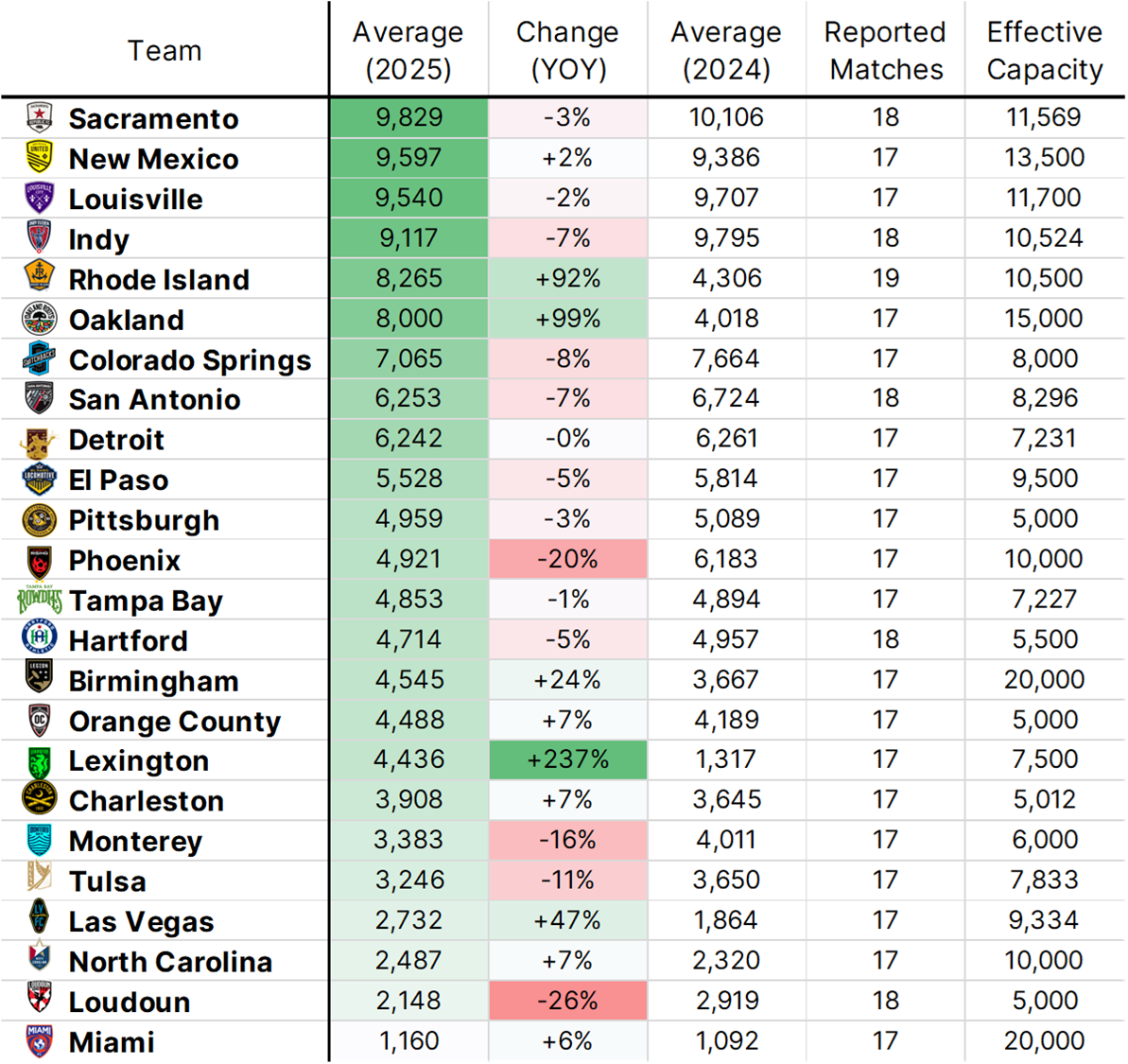
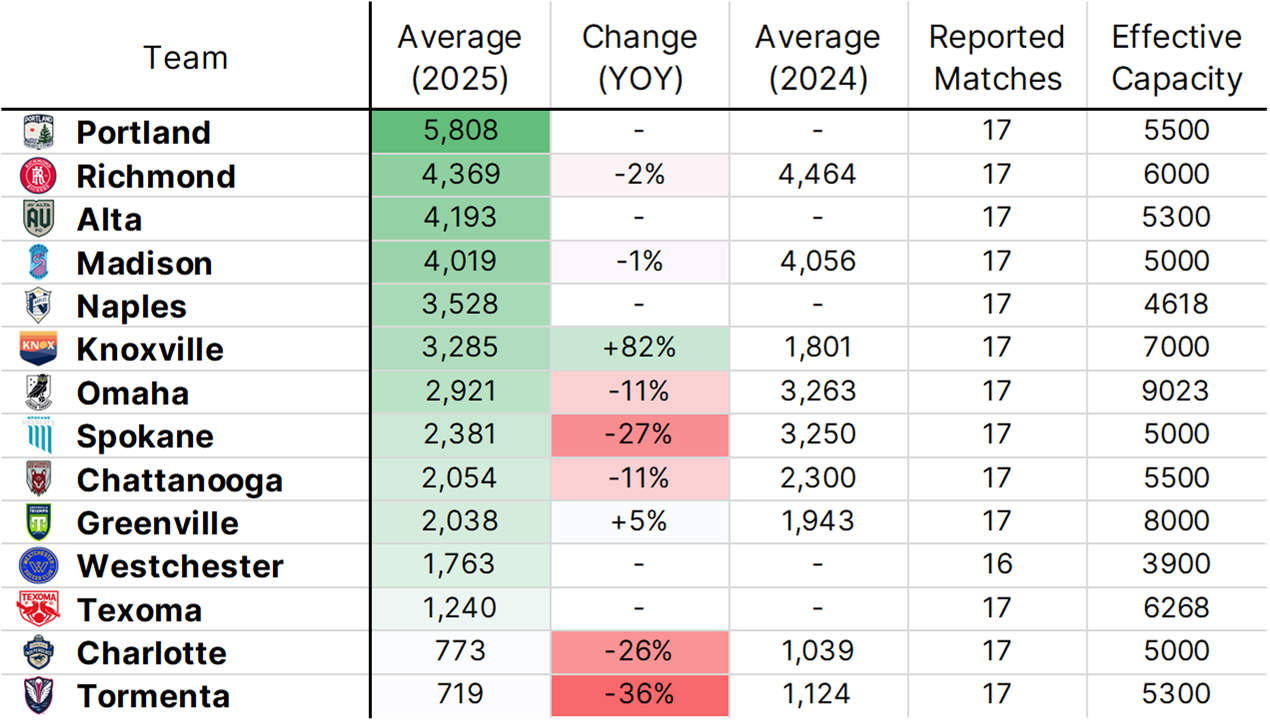
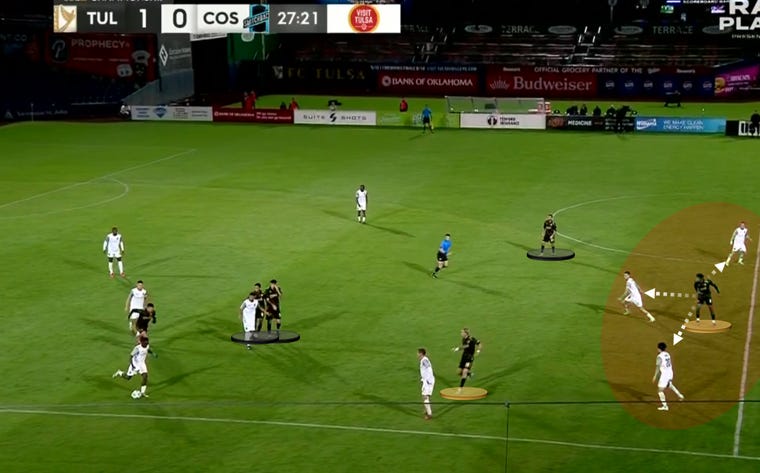
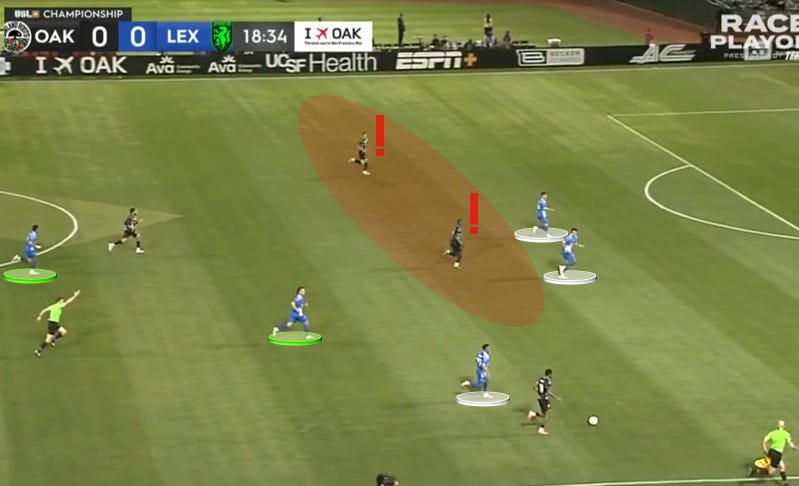
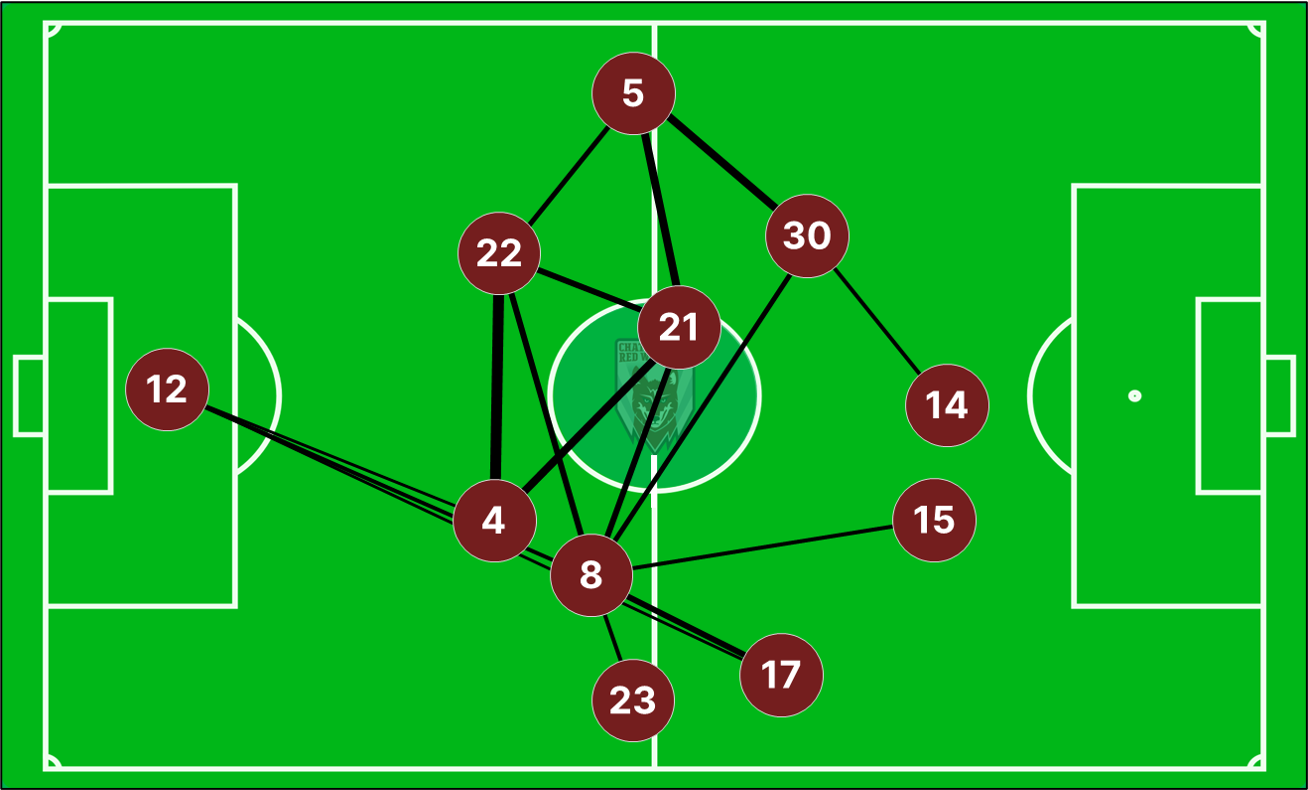
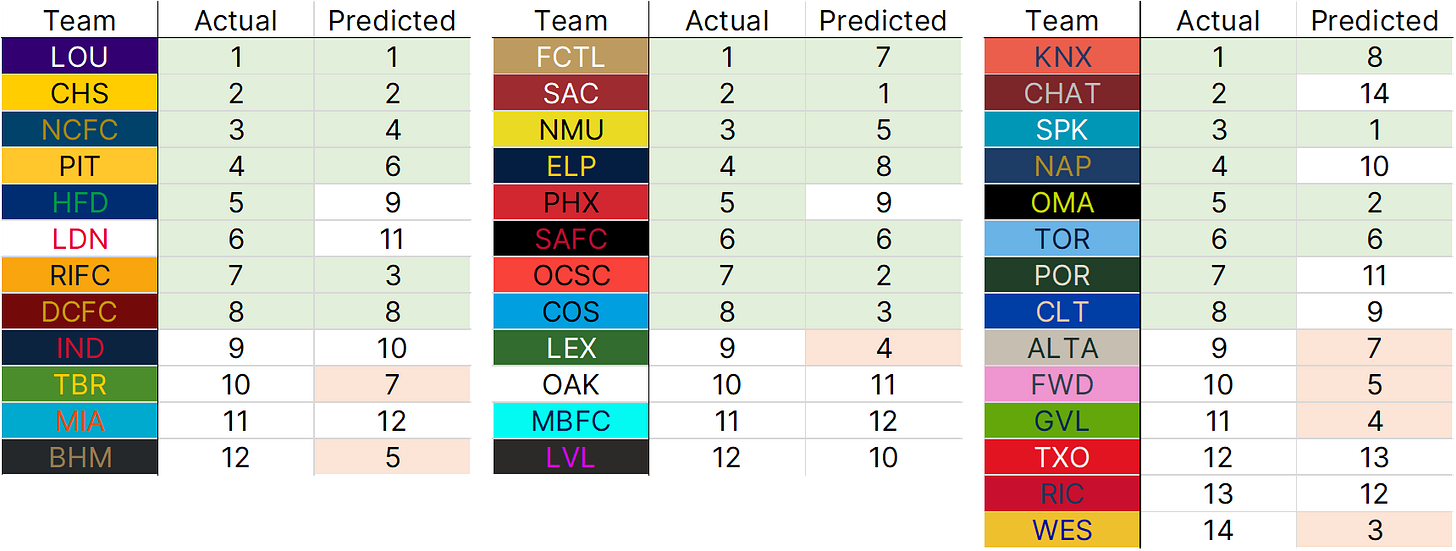
Wonderful piece, as always. And thank you for the plug!
There is no chance on earth that Birmingham actually increased attendance. I was at close to 75% of the matches and most of those games looked like less than 1,000 were in attendance. A significant chuck of legacy fans straight up refuse to come to Protective Stadium because it’s so big and unfriendly to fans.